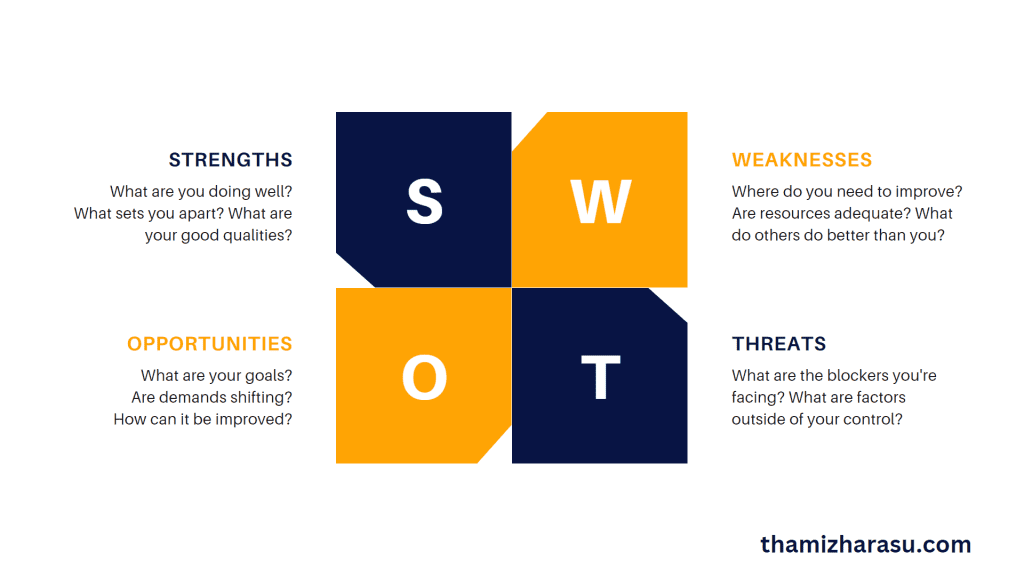- 12/04/2023
- Posted by: Thamizharasu Gopalsamy
- Category: Management

In today’s fast-paced and ever-changing business landscape, a robust and flexible Strategic management principles approach is essential for long-term success. Strategic management principles equip organizations with the tools and techniques needed to navigate market challenges, stay ahead of competitors, and achieve sustainable growth. This blog will explore the key concepts, models, and best practices in strategic management, providing valuable insights for business owners, managers, and professionals seeking to elevate their organizations to new heights.
From understanding the core concepts and frameworks, such as SWOT analysis and Porter’s Five Forces, to set clear goals and objectives, we will delve into various aspects of strategic management. We’ll also discuss the importance of aligning your company’s vision and mission statements, leveraging your core competencies, and effectively monitoring and evaluating your strategic performance. Additionally, we’ll cover essential topics like change management and organizational transformation to ensure your company remains agile and adaptable in an ever-evolving environment.
Whether you’re a seasoned executive or an aspiring entrepreneur, mastering strategic management principles is crucial for steering your business toward success. Join us as we explore these essential concepts and learn how to apply them effectively in your organization.
1. The Pillars of Strategic Management Principles: Understanding the Core Concepts
There are four key pillars of strategic management: understanding the company’s mission, vision, and values; performing a SWOT analysis; setting objectives; and creating a plan of action. Let’s take a closer look at each one.
Mission, Vision, and Values
The first step in any strategic management process is to understand the company’s mission, vision, and values. The mission statement is a brief description of what the company does, while the vision statement outlines what the company hopes to achieve in the future. The values are the guiding principles that underpin everything the company does.
SWOT Analysis
Once the mission, vision, and values have been established, it’s time to perform a SWOT analysis. This involves looking at the company’s strengths and weaknesses, as well as any opportunities and threats that exist in the market. The aim is to identify any areas where the company has a competitive advantage or could potentially improve its performance.
Objectives
After completing a SWOT analysis, it’s important to set some specific objectives. These should be achievable goals that will help move the company closer to its vision. Objectives should be SMART: Specific, Measurable, Achievable, Realistic, and Time-bound.
Action Plan
The final step is to develop an action plan that will help achieve the objectives that have been set. This should include a timeline for each task and who will be responsible for completing it. The action plan should be reviewed.
2. Strategic Planning Process: A Step-by-Step Guide for Business Success
The strategic planning process is a critical part of any business’s journey to success. By taking the time to develop and implement a sound strategy, businesses can set themselves up for long-term growth and profitability.
There are many different approaches to strategic planning, but all successful strategies share some common elements. The following is a step-by-step guide to the strategic planning process, adapted from our book Effective Strategic Planning: A Step-By-Step Guide for Leaders.
1. Define your company’s purpose and goals.
Every business needs to have a clear sense of purpose – what it exists to achieve and why it exists in the first place. This should be reflected in your company’s goals, which should be specific, measurable, achievable, relevant, and time-bound (SMART).
2. Conduct a situation analysis.
Before you can start developing your strategy, you need to understand the current state of your business – where you are today and where you want to be tomorrow. This involves conducting an internal and external analysis to identify your company’s strengths and weaknesses as well as opportunities and threats in the marketplace.
3. Set priorities.
Once you have a good understanding of your current situation, you can start setting priorities for what needs to be done in order to achieve your desired future state. Not everything on your list will be equally important or urgent, so it’s important to prioritize based on what will have the biggest impact on business growth.
3. SWOT Analysis: Identifying Opportunities and Threats for Competitive Advantage
A SWOT analysis is an essential part of any strategic plan. It helps you to identify your company’s strengths, weaknesses, opportunities, and threats. This information is vital in helping you to make informed decisions about where to allocate your resources and how to compete in your market.
When conducting a SWOT analysis, you should start by looking at your internal factors – your company’s strengths and weaknesses. Strengths could include things like a strong brand, innovative products or efficient manufacturing processes. Weaknesses might include a small market share, high costs or dependence on a few key customers.
Once you have identified your internal factors, you need to look at the external environment – the opportunities and threats that exist in the marketplace. Opportunities might include things like new technologies or changing customer trends. Threats could include things like intensifying competition or rising costs.
By taking the time to conduct a SWOT analysis, you will be able to develop a winning strategy for your business that takes into account both your internal capabilities and the external environment. This will give you a competitive advantage and help you to achieve success in today’s highly competitive marketplace.

4. Crafting a Winning Business Strategy: Porter’s Five Forces Model Explained
Porter’s Five Forces Model is a tool that can be used to analyze the competitive landscape of an industry and develop a winning business strategy. The model was developed by Michael Porter, a Harvard Business School professor, and is based on the concept of five forces that shape competition within an industry.
1. Competitive Rivalry:
This force refers to the intensity of competition among existing firms in the industry. A high level of rivalry can result in price wars, aggressive marketing campaigns, and frequent product innovations. Factors influencing competitive rivalry include the number of competitors, industry growth rate, product differentiation, and barriers to exit.
2. Threat of New Entrants:
New companies entering the market can increase competition and reduce profitability for existing players. The threat of new entrants depends on factors such as entry barriers (e.g., capital requirements, economies of scale, brand loyalty), government regulations, and the availability of distribution channels.
3. Threat of Substitute Products or Services:
This force considers the likelihood of customers switching to alternative products or services that fulfill the same need. A high threat of substitutes can put downward pressure on prices and profitability. Factors influencing this threat include the availability of substitute products, their relative price performance, and the propensity of customers to switch.
4. Bargaining Power of Suppliers:
When suppliers have significant bargaining power, they can demand higher prices or impose unfavorable terms, affecting the profitability of companies within the industry. Factors influencing supplier power include the concentration of suppliers, the availability of substitute inputs, the importance of the supplied product to the buyer, and the strength of the suppliers’ brand.

5. Bargaining Power of Buyers:
This force refers to the ability of customers to negotiate lower prices or better terms, which can erode profitability. Factors that influence buyer power include the concentration of buyers, the availability of substitute products, the importance of the product to the buyer, and the degree of product differentiation.
By examining each of these forces, companies can gain insights into their industry’s competitive landscape and devise strategies to counteract or exploit the forces at play. Porter’s Five Forces Model helps businesses identify potential threats and opportunities, enabling them to make informed decisions and maintain a competitive edge in the marketplace.
5. Vision and Mission Statements: How to Set the Right Direction for Your Company
Setting the right direction for your company starts with having a clear vision and mission statement. Your vision should be a long-term view of where you want your business to be, while your mission statement should be a more immediate focus on what you need to do to get there.
Creating a strong vision and mission statement will help you make better decisions about where to allocate your resources and how to best position yourself in the marketplace. It will also give you a north star to guide you when times are tough and you need to make tough choices.
When creating your vision and mission statements, keep the following principles in mind:
1. Be clear and concise: A good vision and mission statement should be easy for everyone in your company to understand and remember. Keep it short, sweet, and to the point.
2. Align with your core values: Your vision and mission statements should be aligned with your company’s core values. This will help ensure that everyone is working towards the same goal and that your actions are consistent with your stated values.
3. Be realistic: Don’t set unrealistic goals that will be impossible to achieve. Set goals that challenge you but are still achievable. Trying to achieve the impossible will only lead to frustration and disillusionment.
4. Focus on what’s important: When setting goals, it’s important to focus on what’s most important to your company. Don’t try to accomplish too many things at once or you’ll spread
6. Strategic Goals and Objectives: Defining Measurable Targets for Long-Term Growth
Strategic goals are the end-game objectives that an organization hopes to achieve. They are usually broad in scope and can take years to accomplish. For example, a company might have a strategic goal of becoming the market leader in their industry.
To achieve these long-term goals, organizations need to set objectives – smaller, measurable targets that will help them track their progress and ensure they stay on course.
There are a few key principles to keep in mind when setting objectives:
1) Objectives should be specific, measurable, achievable, relevant, and time-bound (SMART). This ensures that they are clear and attainable.
2) Objectives should be aligned with the organization’s strategy. They should support and further the strategic goals.
3) Objectives should be challenging but realistic. If they are too easy, there is no motivation to achieve them. If they are too difficult, they may be unattainable and lead to frustration.
4) Objectives should be reviewed and updated on a regular basis as circumstances change and new opportunities arise.
By following these principles, organizations can create objectives that will help them achieve their strategic goals and long-term growth.
7. The Balanced Scorecard: Monitoring and Improving Business Performance
A balanced scorecard is a tool that companies use to monitor and improve business performance. The scorecard provides a framework for companies to track progress against their strategic goals and objectives. The four components of the balanced scorecard are financial, customer, internal process, and learning and growth. Each of these components is important in its own right, but when used together they provide a comprehensive view of company performance.
The financial component measures a company’s bottom-line results. This includes net income, return on investment (ROI), and other financial ratios. The customer component measures a company’s ability to satisfy its customers’ needs and expectations. This includes measures of customer satisfaction, retention, and loyalty. The internal process component measures a company’s efficiency and effectiveness in carrying out its core business processes. This includes measures of quality, cycle time, and productivity. The learning and growth component measures a company’s ability to develop its human capital and improve its organizational capabilities. This includes measures of employee training and development, knowledge management, and innovation.
A balanced scorecard is an important tool for companies to use in monitoring and improving their business performance. By tracking the four key components of the scorecard, companies can identify areas where they need to improve and take corrective action.
8. Core Competencies: How to Leverage Your Company’s Unique Strengths
In order to create a winning strategy, it is essential to understand and leverage your company’s core competencies. Core competencies are the unique strengths and capabilities that give your company a competitive advantage.
There are a few key things to keep in mind when leveraging your company’s core competencies:
1. Understand what your company’s core competencies are.
2. Identify how you can use your company’s core competencies to create a competitive advantage.
3. Make sure that your strategy is aligned with your company’s core competencies.
4. Use your company’s core competencies to execute your strategy effectively.
By understanding and leveraging your company’s core competencies, you will be well on your way to creating a winning strategy!
9. Change Management: Navigating and Leading Organizational Transformations
Today, more than ever, organizations must be able to navigate change effectively in order to remain competitive. This means having a clear understanding of the principles of change management and how to apply them in order to lead organizational transformations.
There are a number of different approaches that can be taken when managing change, but one of the most important things is to ensure that everyone is on board with the new direction. This means communicating the vision and goals for the transformation, as well as getting buy-in from all levels of the organization.
Once the decision has been made to move forward with a change, it’s important to put together a solid plan. This should include setting realistic goals, determining who will be responsible for each task, and establishing a timeline for implementation. Trying to do too much at once can often lead to confusion and frustration, so it’s important to take things one step at a time.
Finally, it’s also critical to monitor progress and make adjustments along the way. Change is rarely easy, but by following these essential principles, organizations can increase their chances of success.
10. Evaluating Strategic Performance: Key Metrics and Best Practices
Strategic performance evaluation is a critical part of the strategic management process. The goal of performance evaluation is to assess how well an organization is achieving its strategic objectives. To do this, organizations need to identify and track key metrics that are aligned with their strategic goals.
There are a number of different ways to evaluate strategic performance. One common method is to use the Balanced Scorecard approach, which balances financial and non-financial measures. Another popular method is the Strategy Map, which visualizes the cause-and-effect relationships between different elements of the strategy.
Whatever method you use, it’s important to select metrics that are relevant to your organization’s specific goals and objectives. Once you’ve identified the right metrics, you can begin tracking them and analyzing your results. This will give you insights into where your organization is performing well and where there are opportunities for improvement.
There are a few best practices to keep in mind when evaluating strategic performance:
1. Set clear and achievable goals: Without clear goals, it will be difficult to measure success. Make sure your goals are specific, measurable, achievable, relevant, and time-bound (SMART).
2. Communicate your goals: Share your goals with all members of your team so everyone understands what you’re trying to achieve.
3. Track progress: Regularly track your progress against your goals so you can identify areas of improvement.
4. Be flexible: Be prepared to adjust your plans according to the situation.
Conclusion
Strategic management principles are an essential tool for the success of any organization. Developing a winning strategy requires careful consideration of the entire organizational environment, from internal and external forces that can shape decisions to the resources available at hand. By understanding these factors, businesses can create plans that will lead them to success and ensure they stay ahead of competitors. With the right strategic planning, organizations can have an advantage in their respective markets and become successful long-term players.
Leave a Reply
You must be logged in to post a comment.
